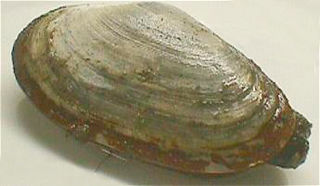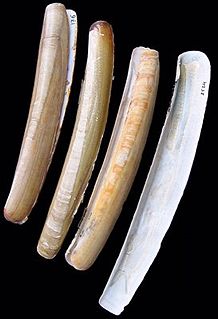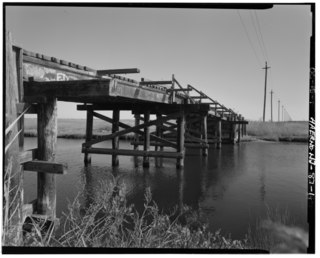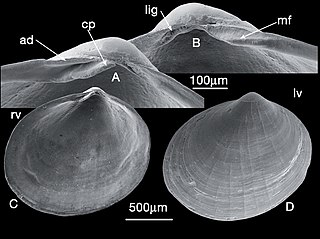
The shipworms are marine bivalve molluscs in the family Teredinidae: a group of saltwater clams with long, soft, naked bodies. They are notorious for boring into wood that is immersed in sea water, including such structures as wooden piers, docks and ships; they drill passages by means of a pair of very small shells borne at one end, with which they rasp their way through. Sometimes called "termites of the sea", they also are known as "Teredo worms" or simply Teredo, from the Greek τερηδώνteredōn, via Latin. Eventually biologists adopted the common name Teredo as the name for the best-known genus.

Bivalvia, in previous centuries referred to as the Lamellibranchiata and Pelecypoda, is a class of marine and freshwater molluscs that have laterally compressed bodies enclosed by a shell consisting of two hinged parts. Bivalves as a group have no head and they lack some usual molluscan organs like the radula and the odontophore. They include the clams, oysters, cockles, mussels, scallops, and numerous other families that live in saltwater, as well as a number of families that live in freshwater. The majority are filter feeders. The gills have evolved into ctenidia, specialised organs for feeding and breathing. Most bivalves bury themselves in sediment where they are relatively safe from predation. Others lie on the sea floor or attach themselves to rocks or other hard surfaces. Some bivalves, such as the scallops and file shells, can swim. The shipworms bore into wood, clay, or stone and live inside these substances.

Ruth Dixon Turner was a pioneering U.S. marine biologist and malacologist. She was the world's expert on Teredinidae or shipworms, a taxonomic family of wood-boring bivalve mollusks which severely damage wooden marine installations.

Teredo navalis, commonly called the naval shipworm or turu, is a species of saltwater clam, a marine bivalve mollusc in the family Teredinidae. This species is the type species of the genus Teredo. Like other species in this family, this bivalve is called a shipworm, because it resembles a worm in general appearance, while at the anterior end it has a small shell with two valves which is adept at boring through wood.

Myida is an order of saltwater clams, marine bivalve molluscs in the subclass Heterodonta. The order includes such bivalves as soft-shell clams, geoducks and shipworms.

Lyrodus is a genus of ship-worms, marine bivalve molluscs of the family Teredinidae.

Pinna carnea, commonly called the amber pen shell, is a species of bivalve mollusc in the family Pinnidae.

Cirratulus cirratus is a species of marine polycheate worm in the family Cirratulidae. It occurs in the littoral and sub-littoral zones of the Atlantic Ocean.

Ensis ensis, or the sword razor, is a razor clam, a marine bivalve mollusc in the family Pharidae. It lives buried in the sand and is found off the coasts of northwest Europe.

Cyrtopleura costata, or the angel wing clam, is a bivalve mollusc in the family Pholadidae. It is found in shallow parts of the northwest Atlantic and also in the North Sea of Scotland coastline and west coast of the Adriatic Sea by a remote area in the Marche region in central Italy, living in the seabed, where it digs its burrows on a very slow revolving movement for years through soft sand and mud always to a max depth of 8ft but always below 3 feet (0.91 m) at the lowest tide.
Kuphus is a genus of shipworms, marine bivalve molluscs in the family Teredinidae. While there are four extinct species in the genus, the only extant species is Kuphus polythalamius. It is the longest bivalve mollusc in the world, where the only known permanent natural habitat is Kalamansig, Sultan Kudarat in the Philippines.

Teredo is a genus of highly modified saltwater clams which bore in wood and live within the tunnels they create. They are commonly known as "shipworms," and are marine bivalve molluscs in the taxonomic family Teredinidae. The type species is Teredo navalis.
Laternula elliptica is a species of saltwater clam, a marine bivalve mollusc in the family Laternulidae, the lantern shells. It is the largest bivalve found under the surface of the seabed in the Southern Ocean.

Venerupis corrugata, the pullet carpet shell, is a species of bivalve mollusc in the family Veneridae. It is found buried in the sediment on the sea bed in shallow parts of the eastern Atlantic Ocean. It is harvested for human consumption in Spain and other parts of Western Europe.

Macoma tenta, the narrowed macoma clam or elongate macoma is a species of clam, a marine bivalve mollusk (bivalvia) in the family Tellinidae and genus Macoma. Macoma tenta are one of two species of macoma clams that can be found in the Chesapeake Bay on the eastern shore of the United States in Maryland and Virginia. The macoma tenta like their cousin in the Chesapeake, the Macoma balthica or Baltic macoma clam, are small marine bivalves with thin, chalky white shells. They tend to live buried in the sandy or muddy areas of shallow water in the middle and lower Chesapeake Bay. Macoma clams are among the most abundant clams in the Chesapeake Bay. Macomas first appeared about 750,000 years ago.

Solecurtus strigilatus, also known as the rosy razor clam, is a species of saltwater clam, a marine bivalve mollusc in the family Solecurtidae. This mollusc is a suspension feeder and can burrow with great rapidity to escape predators. It is an unusual bivalve in that its shell valves are too small to contain all the soft tissue, and the animal is unable to retreat into its shell.

Piling foundations support many historic structures such as canneries, wharves, and shore buildings. The old pilings present challenging problems during restoration as they age and are destroyed by organisms and decay. Replacing the foundation entirely is possible but expensive. Regularly inspecting and maintaining timber piles may extend the life of the foundation.

Adipicola pelagica is a species of saltwater clam, a marine bivalve mollusc in the family Mytilidae, the mussels. It is a deepwater species and is found attached to the bones and tissues of whales that have died and sunk to the seabed, and sometimes to fragments of decomposing carcases which have sloughed off and floated to the surface.
Kuphus polythalamius is a species of shipworm, a marine bivalve mollusc in the family Teredinidae.

Montacuta substriata is a species of small marine bivalve mollusc in the family Lasaeidae. It is found on the eastern side of the Atlantic Ocean where it is often associated with a sea urchin, such as Spatangus purpureus. This species was first described in 1808 by the English naturalist George Montagu who gave it the name Ligula substriata. It was later transferred to the genus Montacuta, making it Montacuta substriata.













